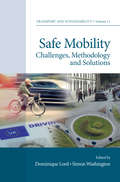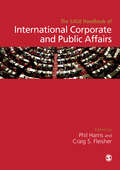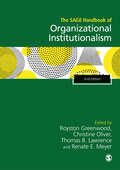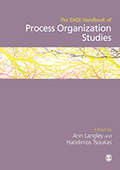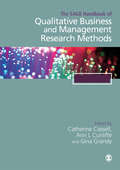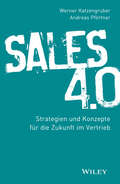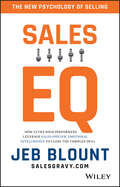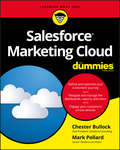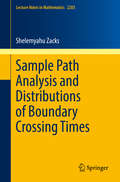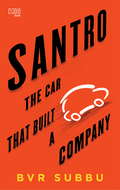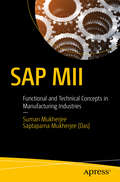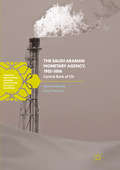- Table View
- List View
Safe Mobility: Challenges, Methodology and Solutions (Transport and Sustainability #11)
by Dominique Lord Simon WashingtonSafe mobility is clearly linked to transport sustainability, as fatalities and injuries resulting from people engaged with transport networks increasingly becomes a public health concern, relative to other health threats. This volume presents the current state of the knowledge across a multitude of analytical and context specific transport safety areas. It includes a comprehensive set of chapters authored by many of the world’s leading experts in both behavioural and engineering aspects of safety mobility. The book increases the level of knowledge on road safety contexts, issues and challenges; shares what can currently be done to address the variety of issues; and points to what needs to be done to make further gains in road safety.
The SAGE Handbook of International Corporate and Public Affairs
by Professor Craig S. Fleisher Professor Phil HarrisThis new edition of The SAGE Handbook of International Corporate and Public Affairs builds on the success of the first edition (2005) by comprehensively updating and enhancing the material and structure, setting a new standard for the practitioner and student of the global public affairs discipline. The new edition includes increased international coverage of the field, and a strong focus on emerging trends, as well as providing a comprehensive overview of the foundations and key aspects of the discipline. The Handbook is organised into six thematic sections, including a generously-sized section devoted to case studies of public affairs in action: Foundations of PA PA and its relationship to other Key Disciplines Emerging Trends in PA The Regional Development and Application of PA Case Studies of PA in Action Tactical Approaches to Executing PA. Containing contributions from leading experts in the field today, this Handbook is designed to serve the needs of scholars, researchers, students and professionals alike.
The SAGE Handbook of International Corporate and Public Affairs
by Professor Phil Harris Professor Craig S. FleisherThis new edition of The SAGE Handbook of International Corporate and Public Affairs builds on the success of the first edition (2005) by comprehensively updating and enhancing the material and structure, setting a new standard for the practitioner and student of the global public affairs discipline. The new edition includes increased international coverage of the field, and a strong focus on emerging trends, as well as providing a comprehensive overview of the foundations and key aspects of the discipline. The Handbook is organised into six thematic sections, including a generously-sized section devoted to case studies of public affairs in action: Foundations of PA PA and its relationship to other Key Disciplines Emerging Trends in PA The Regional Development and Application of PA Case Studies of PA in Action Tactical Approaches to Executing PA. Containing contributions from leading experts in the field today, this Handbook is designed to serve the needs of scholars, researchers, students and professionals alike.
The SAGE Handbook of Organizational Institutionalism
by Thomas B. Lawrence Royston Greenwood Christine Oliver Renate E. MeyerThe SAGE Handbook of Organizational Institutionalism brings together extensive coverage of aspects of Institutional Theory and an array of top academic contributors. Now in its Second Edition, the book has been thoroughly revised and reorganised, with all chapters updated to maintain a mix of theory, how to conduct institutional organizational analysis, and contemporary empirical work. New chapters on Translation, Networks and Institutional Pluralism are included to reflect new directions in the field. The Second Edition has also been reorganized into six parts: Part One: Beginnings (Foundations) Part Two: Organizations and their Contexts Part Three: Institutional Processes Part Four: Conversations Part Five: Consequences Part Six: Reflections
The SAGE Handbook of Organizational Institutionalism (PDF)
by Thomas B. Lawrence Royston Greenwood Christine Oliver Renate E. MeyerThe SAGE Handbook of Organizational Institutionalism brings together extensive coverage of aspects of Institutional Theory and an array of top academic contributors. Now in its Second Edition, the book has been thoroughly revised and reorganised, with all chapters updated to maintain a mix of theory, how to conduct institutional organizational analysis, and contemporary empirical work. New chapters on Translation, Networks and Institutional Pluralism are included to reflect new directions in the field. The Second Edition has also been reorganized into six parts: Part One: Beginnings (Foundations) Part Two: Organizations and their Contexts Part Three: Institutional Processes Part Four: Conversations Part Five: Consequences Part Six: Reflections
The SAGE Handbook of Process Organization Studies
by Ann Langley Haridimos TsoukasThe SAGE Handbook of Process Organization Studies provides a comprehensive and timely overview of the field. This volume offers a compendium of perspectives on process thinking, process organizational theory, process research methodology and empirical applications. The emphasis is on a combination of pedagogical contributions and in-depth reviews of current thinking and research in each of the selected areas, combined with the development of agendas for future research. The Handbook is divided into five sections: Part One: Process Philosophy Part Two: Process Theory Part Three: Process Methodology Part Four: Process Applications Part Five: Process Perspectives
The SAGE Handbook of Process Organization Studies (PDF)
by Ann Langley Haridimos TsoukasThe SAGE Handbook of Process Organization Studies provides a comprehensive and timely overview of the field. This volume offers a compendium of perspectives on process thinking, process organizational theory, process research methodology and empirical applications. The emphasis is on a combination of pedagogical contributions and in-depth reviews of current thinking and research in each of the selected areas, combined with the development of agendas for future research. The Handbook is divided into five sections: Part One: Process Philosophy Part Two: Process Theory Part Three: Process Methodology Part Four: Process Applications Part Five: Process Perspectives
The SAGE Handbook of Qualitative Business and Management Research Methods
by Ann L Cunliffe Professor Cathy Cassell Dr Gina GrandyThe SAGE Handbook of Qualitative Business and Management Research Methods provides a state-of–the-art overview of qualitative research methods in the business and management field. The Handbook celebrates the diversity of the field by drawing from a wide range of traditions and by bringing together a number of leading international researchers engaged in studying a variety of topics through multiple qualitative methods. The chapters address the philosophical underpinnings of particular approaches to research, contemporary illustrations, references, and practical guidelines for their use. The two volumes therefore provide a useful resource for Ph.D. students and early career researchers interested in developing and expanding their knowledge and practice of qualitative research. In covering established and emerging methods, it also provides an invaluable source of information for faculty teaching qualitative research methods. The contents of the Handbook are arranged into two volumes covering seven key themes: Volume One: History and Tradition Part One: Influential Traditions: underpinning qualitative research: positivism, interpretivism, pragmatism, constructionism, critical, poststructuralism, hermeneutics, postcolonialism, critical realism, mixed methods, grounded theory, feminist and indigenous approaches. Part Two: Research Designs: ethnography, field research, action research, case studies, process and practice methodologies. Part Three: The Researcher: positionality, reflexivity, ethics, gender and intersectionality, writing from the body, and achieving critical distance. Part Four: Challenges: research design, access and departure, choosing participants, research across boundaries, writing for different audiences, ethics in international research, digital ethics, and publishing qualitative research. Volume Two: Methods and Challenges Part One: Contemporary methods: interviews, archival analysis, autoethnography, rhetoric, historical, stories and narratives, discourse analysis, group methods, sociomateriality, fiction, metaphors, dramaturgy, diary, shadowing and thematic analysis. Part Two: Visual methods: photographs, drawing, video, web images, semiotics and symbols, collages, documentaries. Part Three: Methodological developments: aesthetics and smell, fuzzy set comparative analysis, sewing quilts, netnography, ethnomusicality, software, ANTI-history, emotion, and pattern matching.
The SAGE Handbook of Sport Management
by Russell Hoye Milena M. ParentThe SAGE Handbook of Sport Management draws together the best current research on the major topics relevant to the field of sports management, including leadership, gender, diversity, development, policy, tourism, and media. Edited by two of the most respected figures in the field, the handbook includes contributions from leading sport management academics from Australia, Canada, New Zealand, USA, the UK and Europe.
The SAGE Handbook of Sport Management (PDF)
by Russell Hoye Milena M. ParentThe SAGE Handbook of Sport Management draws together the best current research on the major topics relevant to the field of sports management, including leadership, gender, diversity, development, policy, tourism, and media. Edited by two of the most respected figures in the field, the handbook includes contributions from leading sport management academics from Australia, Canada, New Zealand, USA, the UK and Europe.
Sales 4.0: Strategien und Konzepte für die Zukunft im Vertrieb
by Werner Katzengruber Andreas PförtnerWerner Katzengruber ist seit mehr als 20 Jahren als Experte im Bereich Sales Management für nationale und internationale Unternehmen tätig. Gemeinsam mit seinem Co-Autor und Mitarbeiter Andreas Pförtner verbinden die Autoren Erkenntnisse aus zahlreichen Projekten mit Informationen aus der aktuellen Forschung. In kaum einen Bereich wird der durch die Digitalisierung ausgelöste Wandel so deutlich wie im Vertrieb. An der Schnittstelle zum Markt entscheidet sich Erfolg oder Misserfolg einer Sales-Strategie. Das Buch ist keine theoretische Übung oder ein Facelift der bestehenden Modelle und Strategien. Es ist für Praktiker und Zukunftsgestalter geschrieben, die sich in komprimierter Form über die zukünftigen Entwicklungen in Vertriebsorganisationen einen Überblick verschaffen wollen. Ziel des Buches ist es, den verantwortlichen Führungskräften Hinweise und Unterstützung bei der Ausarbeitung einer zukunftsorientierten Sales-Strategie zu vermitteln. Dies umfasst mehr als nur den technologischen Einfluss auf das Sales Management, sondern betrachtet das Thema aus einer ganzheitlichen Perspektive. Zielgruppe für dieses Buch sind alle Verantwortlichen aus dem Vertriebsmanagement, unabhängig ob B2B oder B2C, Führungskräfte aus dem General Management sowie Mitarbeiter im Verkauf, die sich für die Zukunft rüsten wollen.
Sales EQ: How Ultra High Performers Leverage Sales-Specific Emotional Intelligence to Close the Complex Deal
by Jeb BlountThe New Psychology of Selling The sales profession is in the midst of a perfect storm. Buyers have more power—more information, more at stake, and more control over the sales process—than any time in history. Technology is bringing disruptive change at an ever-increasing pace, creating fear and uncertainty that leaves buyers clinging to the status quo. Deteriorating attention spans have made it difficult to get buyers to sit still long enough to “challenge,” “teach,” “help,” give “insight,” or sell “value.” And a relentless onslaught of “me-too” competitors have made differentiating on the attributes of products, services, or even price more difficult than ever. Legions of salespeople and their leaders are coming face to face with a cold hard truth: what once gave salespeople a competitive edge—controlling the sales process, command of product knowledge, an arsenal of technology, and a great pitch—are no longer guarantees of success. Yet this is where the vast majority of the roughly $20 billion spent each year on sales training goes. It’s no wonder many companies are seeing 50 percent or more of their salespeople miss quota. Yet, in this new paradigm, an elite group of top 1 percent sales professionals are crushing it. In our age of technology where information is ubiquitous and buyer attention spans are fleeting, these superstars have learned how to leverage a new psychology of selling—Sales EQ—to keep prospects engaged, create true competitive differentiation, as well as shape and influence buying decisions. These top earners are acutely aware that the experience of buying from them is far more important than products, prices, features, and solutions. In Sales EQ, Jeb Blount takes you on an unprecedented journey into the behaviors, techniques, and secrets of the highest earning salespeople in every industry and field. You’ll learn: How to answer the 5 Most Important Questions in Sales to make it virtually impossible for prospects to say no How to master 7 People Principles that will give you the power to influence anyone to do almost anything How to shape and align the 3 Processes of Sales to lock out competitors and shorten the sales cycle How to Flip the Buyer Script to gain complete control of the sales conversation How to Disrupt Expectations to pull buyers towards you, direct their attention, and keep them engaged How to leverage Non-Complementary Behavior to eliminate resistance, conflict, and objections How to employ the Bridge Technique to gain the micro-commitments and next steps you need to keep your deals from stalling How to tame Irrational Buyers, shake them out of their comfort zone, and shape the decision making process How to measure and increase you own Sales EQ using the 15 Sales Specific Emotional Intelligence Markers And so much more! Sales EQ begins where The Challenger Sale, Strategic Selling, and Spin Selling leave off. It addresses the human relationship gap in the modern sales process at a time when sales organizations are failing because many salespeople have never been taught the human skills required to effectively engage buyers at the emotional level. Jeb Blount makes a compelling case that sales specific emotional intelligence (Sales EQ) is more essential to success than education, experience, industry awareness, product knowledge, skills, or raw IQ; and, sales professionals who invest in developing and improving Sales EQ gain a decisive competitive advantage in the hyper-competitive global marketplace. Sales EQ arms salespeople and sales leaders with the tool
Sales EQ: How Ultra High Performers Leverage Sales-Specific Emotional Intelligence to Close the Complex Deal
by Jeb BlountThe New Psychology of Selling The sales profession is in the midst of a perfect storm. Buyers have more power—more information, more at stake, and more control over the sales process—than any time in history. Technology is bringing disruptive change at an ever-increasing pace, creating fear and uncertainty that leaves buyers clinging to the status quo. Deteriorating attention spans have made it difficult to get buyers to sit still long enough to “challenge,” “teach,” “help,” give “insight,” or sell “value.” And a relentless onslaught of “me-too” competitors have made differentiating on the attributes of products, services, or even price more difficult than ever. Legions of salespeople and their leaders are coming face to face with a cold hard truth: what once gave salespeople a competitive edge—controlling the sales process, command of product knowledge, an arsenal of technology, and a great pitch—are no longer guarantees of success. Yet this is where the vast majority of the roughly $20 billion spent each year on sales training goes. It’s no wonder many companies are seeing 50 percent or more of their salespeople miss quota. Yet, in this new paradigm, an elite group of top 1 percent sales professionals are crushing it. In our age of technology where information is ubiquitous and buyer attention spans are fleeting, these superstars have learned how to leverage a new psychology of selling—Sales EQ—to keep prospects engaged, create true competitive differentiation, as well as shape and influence buying decisions. These top earners are acutely aware that the experience of buying from them is far more important than products, prices, features, and solutions. In Sales EQ, Jeb Blount takes you on an unprecedented journey into the behaviors, techniques, and secrets of the highest earning salespeople in every industry and field. You’ll learn: How to answer the 5 Most Important Questions in Sales to make it virtually impossible for prospects to say no How to master 7 People Principles that will give you the power to influence anyone to do almost anything How to shape and align the 3 Processes of Sales to lock out competitors and shorten the sales cycle How to Flip the Buyer Script to gain complete control of the sales conversation How to Disrupt Expectations to pull buyers towards you, direct their attention, and keep them engaged How to leverage Non-Complementary Behavior to eliminate resistance, conflict, and objections How to employ the Bridge Technique to gain the micro-commitments and next steps you need to keep your deals from stalling How to tame Irrational Buyers, shake them out of their comfort zone, and shape the decision making process How to measure and increase you own Sales EQ using the 15 Sales Specific Emotional Intelligence Markers And so much more! Sales EQ begins where The Challenger Sale, Strategic Selling, and Spin Selling leave off. It addresses the human relationship gap in the modern sales process at a time when sales organizations are failing because many salespeople have never been taught the human skills required to effectively engage buyers at the emotional level. Jeb Blount makes a compelling case that sales specific emotional intelligence (Sales EQ) is more essential to success than education, experience, industry awareness, product knowledge, skills, or raw IQ; and, sales professionals who invest in developing and improving Sales EQ gain a decisive competitive advantage in the hyper-competitive global marketplace. Sales EQ arms salespeople and sales leaders with the tool
Salesforce Marketing Cloud For Dummies
by Chester Bullock Mark PollardSalesforce Marketing Cloud: Take your digital marketing on a journey! Everything seems to be moving to the cloud these days—and digital marketing is no exception! Salesforce Marketing Cloud For Dummies guides you through the use of Salesforce's exciting suite of cloud-based digital marketing solutions, which have the power to help you plan, personalize, and optimize your customers' journey. Written by a leader of the Salesforce training and development team, Salesforce Marketing Cloud users will find essential information on using the suite of tools and tips and tricks that only an insider would be able to share. With easy-to-follow instructions, this guide helps you discover how to incorporate your data sets into the tools to create models, campaigns, and customer maps that enable you to create a positive experience for your customers. As Salesforce.com's multi-channel digital marketing platform, the Salesforce Marketing Cloud focuses on helping you manage one-on-one customer journeys. Leveraging a variety of features, this suite of tools offers email marketing, mobile marketing, social media marketing, content and messaging, predictive intelligence, and more. Your ability to navigate these features and functions will determine your digital marketing campaign's success, so it's critical that you make the most of this tool! Navigate and manage the Salesforce Marketing Cloud Define and understand your customers' journeys—and how you fit into them Engage your customers across devices, ensuring consistent communication Use predictive data to optimize engagement Salesforce Marketing Cloud For Dummies helps you make the most of your investment in the digital marketing world!
Salesforce Marketing Cloud For Dummies
by Chester Bullock Mark PollardSalesforce Marketing Cloud: Take your digital marketing on a journey! Everything seems to be moving to the cloud these days—and digital marketing is no exception! Salesforce Marketing Cloud For Dummies guides you through the use of Salesforce's exciting suite of cloud-based digital marketing solutions, which have the power to help you plan, personalize, and optimize your customers' journey. Written by a leader of the Salesforce training and development team, Salesforce Marketing Cloud users will find essential information on using the suite of tools and tips and tricks that only an insider would be able to share. With easy-to-follow instructions, this guide helps you discover how to incorporate your data sets into the tools to create models, campaigns, and customer maps that enable you to create a positive experience for your customers. As Salesforce.com's multi-channel digital marketing platform, the Salesforce Marketing Cloud focuses on helping you manage one-on-one customer journeys. Leveraging a variety of features, this suite of tools offers email marketing, mobile marketing, social media marketing, content and messaging, predictive intelligence, and more. Your ability to navigate these features and functions will determine your digital marketing campaign's success, so it's critical that you make the most of this tool! Navigate and manage the Salesforce Marketing Cloud Define and understand your customers' journeys—and how you fit into them Engage your customers across devices, ensuring consistent communication Use predictive data to optimize engagement Salesforce Marketing Cloud For Dummies helps you make the most of your investment in the digital marketing world!
Salted and Cured: Savoring the Culture, Heritage, and Flavor of America's Preserved Meats
by Jeffrey RobertsFrom country ham to coppa, bacon to bresaola Prosciutto. Andouille. Country ham. The extraordinary rise in popularity of cured meats in recent years often overlooks the fact that the ancient practice of meat preservation through the use of salt, time, and smoke began as a survival technique. All over the world, various cultures developed ways to extend the viability of the hunt—and later the harvest—according to their unique climates and environments, resulting in the astonishing diversity of preserved meats that we celebrate and enjoy today everywhere from corner delis to white-tablecloth restaurants. In Salted and Cured, author Jeffrey P. Roberts traces the origins of today’s American charcuterie, salumi, and other delights, and connects them to a current renaissance that begins to rival those of artisan cheese and craft beer. In doing so, Roberts highlights the incredible stories of immigrant butchers, breeders, chefs, entrepreneurs, and other craftspeople who withstood the modern era’s push for bland, industrial food to produce not only delicious but culturally significant cured meats. By rejecting the industry-led push for “the other white meat” and reinvigorating the breeding and production of heritage hog breeds while finding novel ways to utilize the entire animal—snout to tail—today’s charcutiers and salumieri not only produce everything from country ham to violino di capra but create more sustainable businesses for farmers and chefs. Weaving together agriculture, animal welfare and health, food safety and science, economics, history, a deep sense of place, and amazing preserved foods, Salted and Cured is a literary feast, a celebration of both innovation and time-honored knowledge, and an expertly guided tour of America’s culinary treasures, both old and new.
Salvage ethnography in the financial sector: The path to economic crisis in Scotland (New Ethnographies Ser.)
by Jonathan HearnA historical ethnography of banking practices during the merger of Halifax and Bank of Scotland. Provides insight into the 2008 economic crisis through review of the role of national identities, different styles and ethos of business, tension and unrest prevalent during the merger, and implications for future development within the organisation.
Sample Path Analysis and Distributions of Boundary Crossing Times (Lecture Notes in Mathematics #2203)
by Shelemyahu ZacksThis monograph is focused on the derivations of exact distributions of first boundary crossing times of Poisson processes, compound Poisson processes, and more general renewal processes. The content is limited to the distributions of first boundary crossing times and their applications to various stochastic models. This book provides the theory and techniques for exact computations of distributions and moments of level crossing times. In addition, these techniques could replace simulations in many cases, thus providing more insight about the phenomenona studied.This book takes a general approach for studying telegraph processes and is based on nearly thirty published papers by the author and collaborators over the past twenty five years. No prior knowledge of advanced probability is required, making the book widely available to students and researchers in applied probability, operations research, applied physics, and applied mathematics.
Santro: The Car That Built a Company
by BVR Subbu‘There’s no business like the car business!’ Within months of its launch in late 1998, with every well-known global automobile brand jockeying for a foothold in a small-car market almost monopolized by Maruti Udyog Limited, Hyundai Motor India’s debut production, the Santro, emerged as a force to reckon with. The first car to be conceptualized and designed for – and then developed and manufactured in – India, the ‘Sunshine Car’ has, over a period of sixteen years, set the record for the quickest small car brand to go from zero to one million units sold. It achieved profitability for Hyundai at an unprecedented speed and made an impressive global impact as a made-in-India automobile in markets as diverse as Algeria and Zimbabwe, Western Europe and North America. In Santro: The Car That Built a Company, BVR Subbu, who spearheaded much of the Santro’s success, reveals the hitherto untold story of how this small car made such a big impact. Vivid anecdotes detail the challenges of introducing a new product in a new market, the canny business strategies that were employed to get the better of rival brands, the unforgettable marketing campaigns that made all the difference – and the thrills of the high-stakes power battles and everyday drama that characterize corporate India. By turns revelatory, insightful and delightfully engaging, this is a business story with a difference about a car like no other.
SAP MII: Functional and Technical Concepts in Manufacturing Industries
by Suman Mukherjee Saptaparna MukherjeeLeverage the flexibility and power of SAP MII to integrate your business operations with your manufacturing processes. You'll explore important new features of the product and see how to apply best practices to connect all the stakeholders in your business.This book starts with an overview of SAP's manufacturing integration and intelligence application and explains why it is so important. You'll then see how it is applied in various manufacturing sectors. The biggest challenge in manufacturing industries is to reduce the manual work and human intervention so that the process becomes automatic. SAP MII explains how to bridge the gap between management and production and bring sound vital information to the shop floor in real time.With this book you'll see how to ensure existing manufacturing and information systems share a common interface for all users in your enterprise. What You'll LearnUnderstand the functional aspects of SAP MIIImplement SAP MII in different Manufacturing sectors Explore new technical features of SAP MII 12.x Integrate scenarios with SAP MIIDiscover practice guidelinesWho This Book is forAll levels of SAP manufacturing professionals.
The Satisfaction of Change: How Knowledge and Innovation Overcome Loyalty in Decision-Making Processes
by Manlio Del Giudice Maria Rosaria Della PerutaThis book analyzes the impact of the digital economy on customer satisfaction, shopping experience, resistance to change, script theory, and loyalty. The model introduced assumes that online markets have led to a redefinition of the concepts of loyalty and shopping scripts as a way to reduce customers’ cognitive effort, by optimizing purchase time and increasing the speed and satisfaction of the shopping experience. It describes the utility function of the script by retaining customer loyalty and making the customer more reluctant to abandon his regular supplier. It also explores the difficulty faced by the higher churn rate on the Internet and the minimization of search costs, by integrating more functionality to achieve the ultimate goal of behavioral and cognitive loyalty.The authors provide an analysis in a "digital" view of the economic theory of switching costs and the resulting lock-in mechanisms which, in a classical economy, are often a barrier to disloyalty. It is a useful and effective tool for online businesses, their main managerial and strategic implications, and the adaptability to existing contexts.
The Satisfaction of Change: How Knowledge and Innovation Overcome Loyalty in Decision-Making Processes
by Manlio Del Giudice Maria Rosaria Della PerutaThis book analyzes the impact of the digital economy on customer satisfaction, shopping experience, resistance to change, script theory, and loyalty. The model introduced assumes that online markets have led to a redefinition of the concepts of loyalty and shopping scripts as a way to reduce customers’ cognitive effort, by optimizing purchase time and increasing the speed and satisfaction of the shopping experience. It describes the utility function of the script by retaining customer loyalty and making the customer more reluctant to abandon his regular supplier. It also explores the difficulty faced by the higher churn rate on the Internet and the minimization of search costs, by integrating more functionality to achieve the ultimate goal of behavioral and cognitive loyalty.The authors provide an analysis in a "digital" view of the economic theory of switching costs and the resulting lock-in mechanisms which, in a classical economy, are often a barrier to disloyalty. It is a useful and effective tool for online businesses, their main managerial and strategic implications, and the adaptability to existing contexts.
The Saudi Arabian Monetary Agency, 1952-2016: Central Bank of Oil
by Ahmed Banafe Rory MacleodThis book sheds new light on the critical importance of the Saudi Arabian Monetary Agency (SAMA), a remarkably successful central bank that is a model for developing oil exporters worldwide. As a "swing producer", Saudi Arabia has traditionally stepped in to make up for oil supply shortfalls in other OPEC countries, or to scale back their own production when overabundance might lead to a price crash. Since 2014, Saudi Arabia has changed its policy in response to the rise of American shale oil, in search of a long-term strategy that will, once again, help balance supply and demand at a steady price. In its informal dual role of central bank and sovereign wealth fund, SAMA must navigate the paradoxes faced by monoline oil producing countries: the need for diversification vs. dependence on oil-based revenue; the loss of foreign exchange reserves that follows oil-financed government spending; the unreliability of revenue from oil; the challenges of using a Western model for supervising Shariah-compliant banks; and the need to have a balancing mix of oil and financial assets. As SAMA (now the Saudi Arabian Monetary Authority) reassesses its role in 2017, this history and guide to current policy issues will prove invaluable for policymakers in oil producing economies looking to apply lessons from the past as they plan for the future.
The Saudi Arabian Monetary Agency, 1952-2016: Central Bank of Oil
by Ahmed Banafe Rory MacleodThis book sheds new light on the critical importance of the Saudi Arabian Monetary Agency (SAMA), a remarkably successful central bank that is a model for developing oil exporters worldwide. As a "swing producer", Saudi Arabia has traditionally stepped in to make up for oil supply shortfalls in other OPEC countries, or to scale back their own production when overabundance might lead to a price crash. Since 2014, Saudi Arabia has changed its policy in response to the rise of American shale oil, in search of a long-term strategy that will, once again, help balance supply and demand at a steady price. In its informal dual role of central bank and sovereign wealth fund, SAMA must navigate the paradoxes faced by monoline oil producing countries: the need for diversification vs. dependence on oil-based revenue; the loss of foreign exchange reserves that follows oil-financed government spending; the unreliability of revenue from oil; the challenges of using a Western model for supervising Shariah-compliant banks; and the need to have a balancing mix of oil and financial assets. As SAMA (now the Saudi Arabian Monetary Authority) reassesses its role in 2017, this history and guide to current policy issues will prove invaluable for policymakers in oil producing economies looking to apply lessons from the past as they plan for the future.
Saving a Place: Endangered Species in the 21st Century
by John A. Baden Pete GeddesThis title was first published in 2000: The noble goals embodied in the Endangered Species Act are colliding with financial and social realities. Citizens increasingly face the costs of current policies, while initiatives which fail to respect liberty and property meet serious resistance at every turn. Despite widespread verbal support for saving species ’at any cost’, when trade-offs become obvious, and values compete, support for these policies evaporates. This edited collection examines ethically and materially responsible approaches to this problem, written by leading international figures from a variety of disciplines. The result is the most comprehensive and constructive analysis of the effectiveness and viability of endangered species protection available.
